
Once the radio is powered on, the application will display the current and standby frequencies, standby the smaller lower frequency, active the larger upper frequency.
Nearby frequencies can be scrolled through by turning the dial, or selecting the scanner in the bottom left, active and standby can be swapped by pressing on either standby or active frequencies, or via the simulator controls for the radio.
To make a transmission, press and hold TRANSMIT and speak into the microphone.
The arrows to the left and right of the page scroll through the sub pages of the application, these can also be reached by swiping left and right on the page.
Making a transmission
To make a transmission, press and hold the transmit button and speak into the microphone. You voice will be converted to text and sent to the current controller.

When you release the transmit button, your request will be converted to text and displayed for a short time, configurable in settings, before being sent. To correct the message before it is sent, press and transmit again before the timer expires.
Requests will not be received by a controller unless you have registered your call sign (see the next section), and are tuned to a radio receiver in range of your current position.
For best recognition accuracy and realism a headset with microphone should be used. Even those typically provided with mobile phones will greatly improve accuracy over a built in device microphone.

Mini Map
The mini map page centers on the local position, aircraft are shown with their current flightpath.
Most icons can be selected to view further information such as their name and Frequency:
 NDB
NDB
 VOR
VOR
 DME
DME
 Waypoint Fix
Waypoint Fix
 VFR reference point
VFR reference point
The circled point below the mini map can be used to return to the current aircraft position.
When the application is operating in self contained mode, the aircraft will move to the center of the map as the map is panned.

Frequency Scanner
Reception of transmissions varies depending on location, altitude and surrounding terrain. AutoATC models these and periodically updates stations that should be able to receive radio communications from the current location.
This list of in range frequencies populates the next and previous radio frequency commands in the simulator, the dial on the frequency page, and also the scanner page within the application.
The scanner page shows the description of the frequency along with the frequency
Selecting an entry tunes the standby frequency.
Back exits.

Transponder Setting
The transponder frequencies received from air traffic control can be set via the transponder page. This page also includes a clock displaying the current time in UTC.

Log window
To aid in following the communications, the log window shows various information, such as the current airspace name and category, the station the radio is currently tuned to, along with a history of received and sent transmissions.

FMC Integration
When the application is connected to a compatible aircraft in the simulator (such as the Sparky747), and extra page will become available to interact with the FMC remotely.